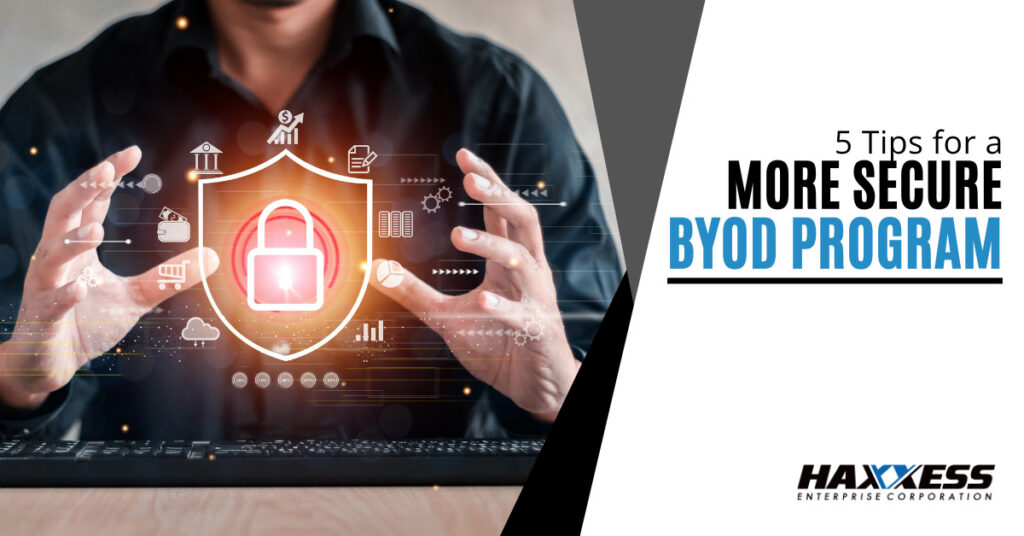
BYOD, also recognized as ‘Bring Your Own Device,’ has continuously risen in workplaces worldwide. However, there are benefits attached to it, but so are risks. Employers/business owners must find effective procedures to balance employees’ data security and freedom for a successful and balanced BOYD program.
When staffs bring their personal devices to work for private or confidential communications and transactions, it is less risky until those personal devices are used for corporate interactions. That practice causes substantial IT security risks, whether accessing the organization’s applications or sending corporate emails from their personal devices (tablets, smartphones, or PCs).
According to research, 40% of IT security breaches in firms/businesses are a result of stolen or lost devices. That is problematic as firms can lose confidential/sensitive data, damaging the organization’s reputation and lower productivity. Therefore, firms should consider adopting defined BOYD enforcement and policies.
If managers or employers should deny the fact that BOYD programs can result in security risks, then they’ve gotten it all wrong. Though the advantages of BOYD indeed outweigh potential security risks, this piece would give more information regarding the ‘meager’ risks that could surface because taking preventive measures is far greater than finding solutions after an attack.
As stated above, there are fairly a number of benefits accrued to the BYOD system, but it isn’t flawless as well. For most small or medium businesses, the greatest risk circles around losing a grip on their sensitive data. Unfortunately, most firms cannot enforce strict BYOD security policies, which could cause diverse security issues or challenges.
For instance, a wide range of firms has sternly enacted policies regarding some IT measures like VPNs, passwords, and the like. On the other hand, it is problematic from the technical and logical perspective to create and much more challenging to implement these policies using the BYOD system. Just as you may imagine, that can significantly cause a surge of malware infection or data breaches.
Although, as stated in this section above, it is pretty challenging, do not be scared. It is possible to use BYOD and still mitigate risks for a more Secure BOYD program.
Below are crucial tips/guidelines to help organizations enjoy a more secured BYOD program:
Every tablet, smartphone, and PC has inbuilt control panels. Therefore, as one out of your BYOD agreements, your employees must have the security passcode activated before they can be permitted to access the organization’s resources. Enact the rule of every staff device to use the MFA (Multifactor Authentication) on their devices because most people rely on nothing or just a four-word or digit pin passcode as security measures for their devices.
As a business owner or manager, ensure that your IT personnel keeps a track record of your employee’s device details as they connect to the company’s network. That way, you’ll have the chance to audit your organization’s network constantly to identify unauthorized resource usage and connections.
Pay attention to your employee’s anxieties concerning productivity, privacy, and the capacity to make use of their personal devices for other personal purposes when they are not within the working environment. These policies should include close monitoring of staff location as well as why such is needed. Also, ensure that your staff’s sensitive data is saved correctly and protected.
Ensure that your employee’s qualifications expire after a given period. Do not authorize devices automatically as well. If not, you may experience issues when one of your staff gives any of their devices to one of their kid or ward to play games so as to keep them calm – do not assume that the legal user of the device is the one connecting.
Smartphones and tablets are common devices that are passed around for neighbors, friends, or even strangers to make a quick call.
Educate your staff on ways to keep their personal devices upgraded. Tablets and phones should be required to have the latest form of software which is reinforced by their respective hardware. Also, you can instruct your IT team to go through your staff phones once a week to see if their devices have properly been upgraded or when a recent OS upgrade is available.
For instance, you can as well ensure (by stating it in your policy) that your staff is required and permitted to have the latest form of an Android device. That way, it could force some of them to get a new device; especially if they didn’t adhere to the previously created rules/policies.
Organizations really need to successfully balance IT security issues with privacy and protection anxieties of users and employees. When policies are too strict, the staff tends to be resentful, and that could reduce the benefits of adopting the BYOD program initially.
So far, technology is one of the best ways to grow your business as a business owner or manager. With the constant advancement of technology and technology-related devices, firms worldwide have snowballed using outsourced IT security programs.
Outsource your IT needs with Haxxess to experience sustained IT solutions. Contact us today!